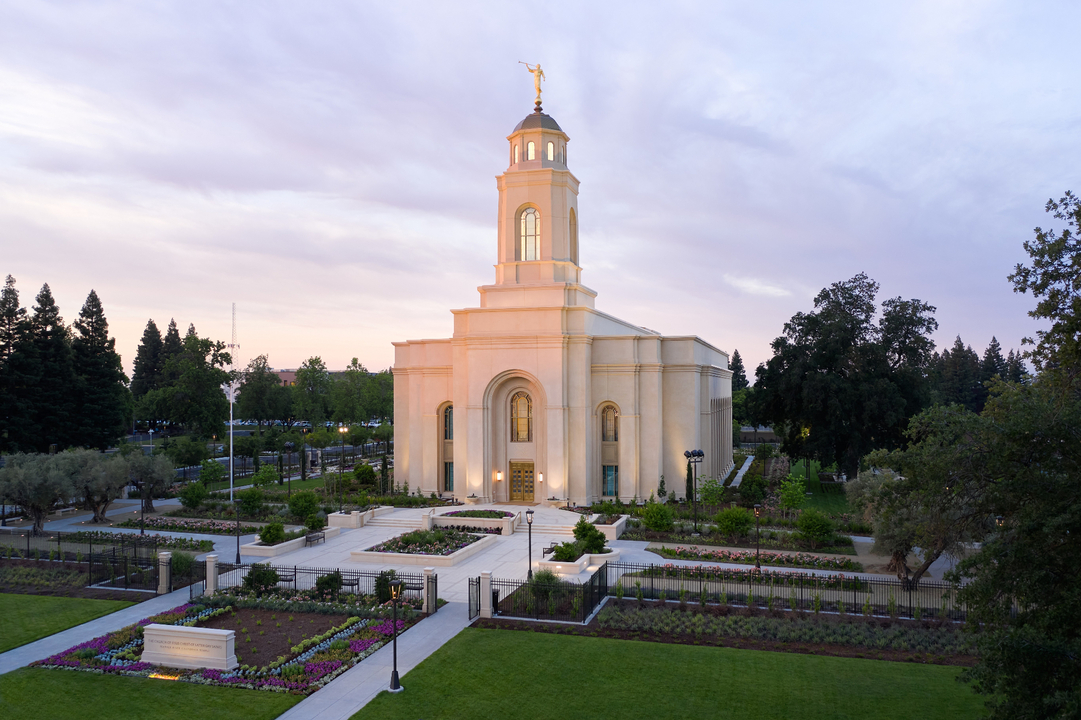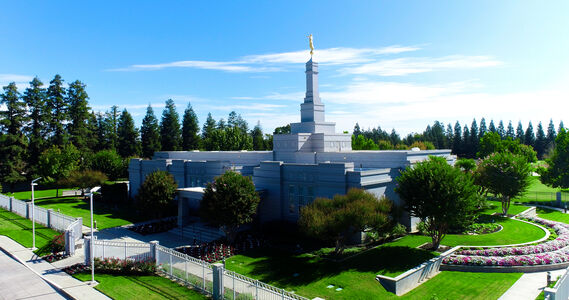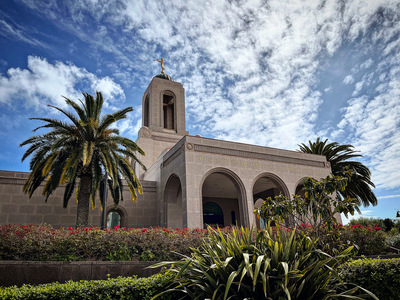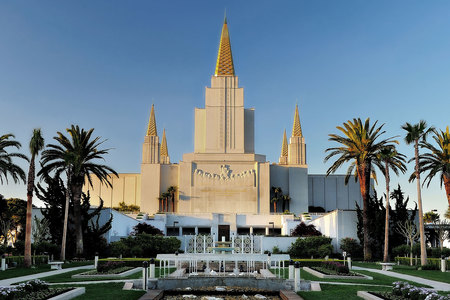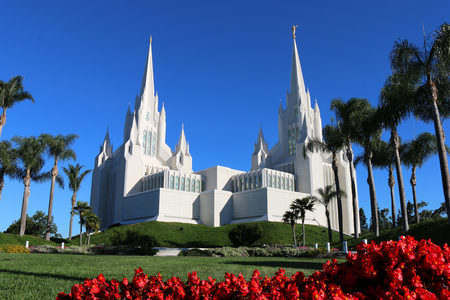Services
NO visitors' center open to the publicNO arrival center available
NO patron housing available
Distribution center on site (Store Locator)
Announcement:
7 October 2018Groundbreaking and Site Dedication:
18 July 2020 by Paul H. WatkinsPublic Open House:
19 August–9 September 2023Dedication:
8 October 2023 by Ulisses SoaresSite:
9.24 acres | 3.7 hectaresExterior Finish:
Cream precast concrete panels fabricated by Willis Construction in San Juan Bautista, CaliforniaArchitectural Features:
Single attached end tower with an angel Moroni statueOrdinance Rooms:
Four instruction rooms, three sealing rooms, and one baptistryTotal Floor Area:
41,665 square feet | 3,871 square metersHeight:
135 feet | 41.1 metersElevation:
60 feet | 18 metersTemple Facts
The Feather River California Temple was the eighth temple built in California.
The Feather River California Temple was originally announced as a temple planned for Yuba City, California.
Temple History
Announcement
President Russell M. Nelson announced plans for the construction of the Feather River California Temple in his closing remarks at the 188th Semiannual General Conference. The Feather River California Temple would become the eighth in the state, joining the Los Angeles California Temple (1956), Oakland California Temple (1964), San Diego California Temple (1993), Fresno California Temple (2000), Redlands California Temple (2003), Newport Beach California Temple (2005), and Sacramento California Temple (2006). California was home to over 760,000 Church members organized into nearly 1,300 congregations.1
Location and Rendering
On September 26, 2019, the location of the Feather River California Temple was announced. It would be constructed on the site of the stake center for the Yuba City California Stake at 1470 Butte House Road. A small adjoining parcel was also acquired from Yuba City. The stake center was demolished and replaced by the temple, a new stake center, and a distribution center. The news release was accompanied by an official exterior rendering of the temple.2
Groundbreaking
Elder Paul H. Watkins, Area Seventy, presided at a small groundbreaking ceremony for the Feather River California Temple on Saturday, June 18, 2020. Attendance was limited by COVID-19 social distancing guidelines. In his site dedicatory prayer, Elder Watkins prayed, "As the temple foundation is poured, and the walls are placed, and the roof is formed, let us all revitalize our foundational faith in apostles and prophets with Jesus Christ being our chief cornerstone."3
Open House and Dedication
On March 20, 2023, the First Presidency announced the opening dates for the Feather River California Temple. The public open house was held Saturday, August 19, through Saturday, September 9, 2023, with no tours held on Sundays. Elder Ulisses Soares of the Quorum of the Twelve Apostles dedicated the temple in two sessions on Sunday, October 8, 2023. Both sessions were broadcast to all units in the temple district. A media day kicked off the open house on Tuesday, August 15, followed by tours for invited guests from Wednesday, August 16, through Friday, August 18, 2023.4
Temple Design
Exterior
The building is constructed of structural steel and precast concrete panels, fabricated and installed by Willis Construction in San Juan Bautista, California.
Richardson Design Partnership designed the art glass with assistance from Holdman Studios. The glass’s main design motif is the regionally significant almond blossom.
The landscape architect is Loci, with local support from HLA Group of Sacramento, California. The landscape plan is inspired by the mediterranean climate of the Sacramento Valley and the area’s rich history and biodiversity. The design incorporates several mature native oak, redwood, and hackberry trees already on the site. Some prominent features are the 100-year-old olive trees transplanted from a local orchard, which will be arranged in groves both in front of and behind the temple.
The temple grounds are enclosed with a six-foot-tall steel picket fence, powder-coated with a bronze color to match other metal fixtures on the site. Precast concrete pillars are located at the gated entrances to the grounds.
Interior
The general carpet pattern was pulled from early Christian architecture. The green color represents the rice fields and the farming community in the area. The carpet carving design incorporates the almond flower to coordinate with the art glass. The rug designs are reminiscent of an open field of local wildflowers and the California poppy, the state flower. The stone floor consists of Crema Beige (Iran), Emperador Light (Turkey), Inca Gold (Pakistan), Verde Lichen (Iran), Rojo Alicante (Spain), and Vanilla (Turkey) marble. Colors were chosen to correspond with the fabrics and represent the local flora. The stone pattern throughout the building references other buildings in the area. The stone pattern around the baptistry is pulled from the art glass designs.
Decorative paint is used in a simple fashion along the patron path. In the ordinance areas, the decorative paint is an abstraction of the local flora and its underlying geometry. It is used to accentuate the architecture at key points and connections. It signifies the natural beauty of the local area and the principles that contribute to that beauty.
Art glass is in all the windows of the temple. The arched windows of the second level and the ordinance spaces depict the almond blossom, representing the agricultural industry of the area. It is a celebration of beauty and the rewards of hard work. The natural colors of the almond blossom are used against a backdrop of yellow fading to blue.
The interior lights are brass, with crystal being added in the ordinance spaces. All the fixtures feature a shallow bowl. In the ordinance rooms, the shallow curve of the bowl is in opposition to the vault of the ceiling, representing two complementary elements that complete the circle.
Decorative millwork is used on the altars, the recommend desk, the baptismal font, and the doors leading into ordinance spaces. The pattern used in the millwork is a modified quatrefoil. This again comes from early Christian architecture and is an abstraction of the four-leaf clover.
The font railing is an abstraction of tall reeds that grow at the edges of bodies of water. It also draws on the shape of the rice plant grown extensively in the area.
The doors are made of cherry wood, cherries being a significant agricultural product in the area. The door hardware is brass. The hardware design uses arches as well as a reed-and-ribbon motif. The design also features abstract forms of flora.
Simple textured wallcoverings are used throughout the building. A leaf pattern adorns the bride’s room, hearkening to the art glass and rug designs. This leaf pattern is derived from early Christian representations of the olive branch.
The ceilings in the temple’s ordinance spaces are vaulted. This is a reference to early Christian and local historical architecture.
Temple Background
Wearing face masks amid the COVID-19 pandemic, helpers removed cabinets and doors, furniture, pews and even the gymnasium floor of the Yuba City California Stake Center, a multicongregational house of worship for members of The Church of Jesus Christ of Latter-day Saints.
The building, which served Latter-day Saints for more than 40 years in the twin cities of Marysville and Yuba City, was razed to make way for what is regarded as the most sacred of structures to members of the faith: a temple.
Church President Russell M. Nelson announced plans in 2018 to build the 38,000-square-foot Feather River California Temple at 1470 Butte House Road in Yuba City.
“Many people have felt like this ground is sacred,” said local Church leader Yuba City California Stake President Steve Hammarstrom, referring to the familiar landmark. “When you walk around, you can feel it.”
The Tumber Family
In the early 1970s, before the Church owned the property, Mehar Tumber and his family, devout Sikhs, owned the land, where they grew peaches. His widow, Surjit, and her children fondly remember Mehar as a man of great faith. “He loved God,” Surjit recalled. “He was a gentlemen’s gentleman and with that, came his spirituality and his belief in God,” added his son, Ravi.
During that time, the Church had difficulty locating suitable acreage on which to build a stake center. Mr. Tumber was not in the market to sell, but that changed when he was approached by representatives of the Church.
Mehar’s daughter, Raji, remembers the day her father announced to the family he had sold the property to the Church. “He had the biggest smile on his face and was so happy,” she recalled. “He thought it was a blessing to have a religious organization … as an anchor to our property.”
For nearly 50 years, the relationship between the Tumbers and the Church has grown in mutual respect and admiration. “There’s a special spirit associated with their faith and our faith, merging together,” said President Hammarstrom.
“Dad was so thankful that it went to a church and it was about God,” said Ravi.
“The roots are established here for this place, this location and what’s surrounding it,” added Raji. “With the new temple, it’s just deeper roots.”
As with the Tumbers and their Latter-day Saint neighbors, a similar friendship has formed between the Church and the Yuba-Sutter community at large.
“This is a small town. We can’t do without each other,” said John Nicoleti, deputy director of Yuba-Sutter Habitat for Humanity. “Our faith community is actually in an uptick. We’re excited about the new temple.”
Repurposing Stake Center Material
That bond of fellowship was exemplified in the outpouring of service in May 2020, when more than a dozen different faith and charity organizations helped dismantle and repurpose valuable material from the Church’s Yuba City California Stake Center, ensuring it has another chance to benefit others in the community.
“We want to give some of what we are to others,” said local Church leader Paul Watkins, an Area Seventy in the North America West Area. “This, in some ways, symbolizes that.”
President Hammarstrom added, “Even though the building’s going away, a piece of it is living on in more than a dozen churches and other … nonprofits and schools.”
Habitat for Humanity
Solid-wood doors and cabinets from the stake center were given to Habitat for Humanity’s ReStore, which helps fund the construction of new homes. “We’re probably dealing with 10 or 20,000 dollars’ worth of basic materials, because it’s in really good condition,” said Nicoleti, who estimated the money will help place families into new homes.
Yuba-Sutter Community Task Force
This latest service project is not unusual for the twin cities of Marysville and Yuba City but rather the norm. It’s the result of a remarkable concept forged out of love and friendship, known as the Yuba-Sutter Community Task Force.
Marysville City Council member Stephanie McKenzie said divine inspiration was instrumental in creating the task force.
“What has been the most successful are the relationships that we’ve built. We know each other. We trust each other,” said McKenzie, who is also the director of the committee. “Because of those relationships … everybody is so supportive of each other. It’s so easy to make something happen. We just say, ‘OK, we’re in this together.’”
Virgil Atkinson, a Latter-day Saint who has served on the task force since its inception, said, “The task force is the vehicle to bring all of the churches and all of the political entities … and organizations … together. And so, that breaks down that wall between everybody.”
Atkinson helped many of the faith and charity organizations in the twin cities procure their lists of needed items from the stake center prior to dismantling. “We walked the halls with about 12 to 14 different pastors and organizations. That was a cherished experience,” he remembered.
Bethel A.M.E. Church
Gwen Ford was part of the group with Atkinson and is the church administrator for one of the oldest African American churches in California, which dates back to the gold rush era. “We are planning to start a couple of nonprofits, economic development and education,” said Ford.
The Bethel A.M.E. Church does a lot with very little. Folding chairs, chalkboards and display stands and cases are a welcome addition to the church’s community efforts. In addition, a decorative stone bench now complements the A.M.E. Church entrance.
“We can’t afford to buy this stuff,” said Ford. “[These] things are going to be very, very helpful. It’s not an overabundance of things, but it’s the exact things that we need.”
Faith Lutheran Church
The Yuba stake center’s baby grand piano is exactly what the Faith Lutheran Church needed. Its music now accompanies worship services and chorale performances. Pastor Bernie Fricke, a talented singer and chorale leader, said the new piano replaced their well-used piano. “We’re not a money-making church with our concerts, but we certainly want to serve the community. So I was very happy for the Church to offer that for us.”
Five30 Church and Events Center
Pastor Jim Carpenter said he was divinely inspired to create a church and events center as a refuge for the community. “It’s about our common ground. And what we’re doing with the change that we want to see in our culture, our community, our society.”
Pastor Carpenter said it was a tender mercy and a literal answer to prayer when he got a call from his Latter-day Saint friends. His newly organized church needed chairs — lots of chairs — that could quickly be set up and taken down for various events. “What we need is the convenience of the folding chairs, and not only the folding chairs but the carts to stack it up and make a smooth turnaround.”
Smaller items that help a church and events center function were also needed, but they were pricey to purchase on the ministry’s budget. “My wife had just made a list and said, ‘Lord, we need water pitchers, and we need salt and pepper shakers.’ We walked [into the stake center kitchen] and there’s this tray full of 50 sets of salt and pepper shakers. I said, ‘I will take those!’ My faith grew immediately,” recalled the pastor.
Cherished Relationships, New Beginnings
What was cultivated by a gracious peach grower more than 40 years ago has borne amazing fruit and promises so much more to Latter-day Saints and their friends and neighbors as they say goodbye to an old friend and hello to a new one: the Feather River California Temple.
“This church and our house — it’s all been blessed a million times,” reflected Raji Tumber. “We are glad Dad made that decision [to sell].”
“The temple coming here … is special. And he would be absolutely thankful for it over anything else,” added Ravi Tumber.5
- "Twelve Temples Announced as October 2018 General Conference Closes," The Church of Jesus Christ of Latter-day Saints News Release, 7 Oct. 2018.
- "Rendering Released for the Feather River California Temple," The Church of Jesus Christ of Latter-day Saints News Release, 26 Sept. 2019
- "Ground Broken for Feather River California Temple," The Church of Jesus Christ of Latter-day Saints News Release, 18 Jul. 2020.
- "Temple News from North and Central America," The Church of Jesus Christ of Latter-day Saints News Release, 20 Mar. 2023.
- "The Feather River California Temple Is Ready for Public Tours," The Church of Jesus Christ of Latter-day Saints News Release, 15 Aug. 2023.

